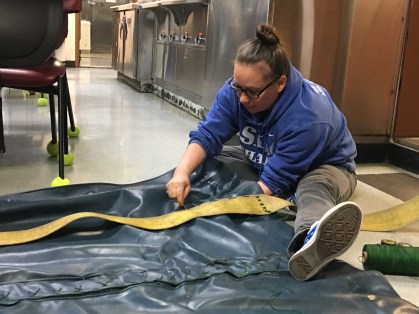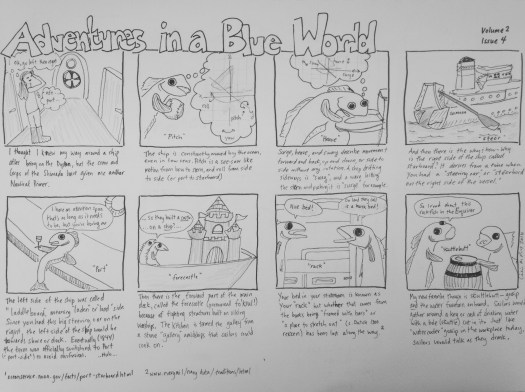NOAA Teacher at Sea
Brad Rhew
Aboard NOAA Ship Bell M. Shimada
July 23 – August 7, 2017
Mission: Hake Survey
Geographic Area of Cruise: Northwest coast
Date: July 28, 2017
Weather Data from the Bridge
Latitude 4359.5N
Longitude 12412.6 W
Temperatue: 54 degrees
Sunny
No precipitation
Winds at 23.5 knots
Waves at 2-4 feet
Science and Technology Log
We are officially off! It has already been an amazing experience over the last couple of days.
One of the goals of this project is to collect data that will be used to inform the Pacific hake stock assessment. This falls in line with the Pacific Whiting Treaty that the US-Canadian governments enacted to jointly manage the hake stock. NOAA and Department of Fisheries and Oceans-Canada (DFO) jointly survey and provide the hake biomass to the stock assessment scientists. (Refer to the link in my last blog about additional information on this treaty.) Major goals of the survey are to determine the biomass, distribution, and biological composition of Pacific hake using data from an integrated acoustic and trawl survey. Additionally, we are collecting a suite of ecological and physical oceanographic data in order to better understand the California Current Large Marine Ecosystem (CCLME).
There is a very detailed process the scientists go through to collect samples and data on the hake caught and selected for sampling. They want to learn as much as possible about these fish to help with the ongoing research projects.
Here is a quick guide and understanding of how sampling works and what data is collected:
- Determine the length and sex of the fish.
- To determine the length, the fish is placed on a magnetic sensor measuring board. The magnet is placed at the fork of the tail fin; the length is recorded into the data table. (See figure A.)

Figure A. Determining the length of the fish. - To determine the sex, the fish is sliced open on the side. Scientist look to see if ovaries (for females) or testes (for males) are present. They also can determine the maturity of the fish by looking at the development of the reproductive organs. (See figure B.)
- To determine the length, the fish is placed on a magnetic sensor measuring board. The magnet is placed at the fork of the tail fin; the length is recorded into the data table. (See figure A.)
- Determine the mass.
- Removing of the otoliths (ear bones).
- Hake have two otoliths. How this is done is the scientist first cuts a slight incision on top of the fish’s head. (See figure D.)

Figure D. Making an incision on the fish’s head to remove otoliths. - The head is then carefully cracked open to expose the bones. (See figure E.)
- The bones are removed with forceps and then placed in a vial. The vial is then barcode scanned into the database. The otoliths will then be sent to the lab for testing. Scientists can run test on the otoliths to determine the age of the selected fish. (See figures F and G.)
- Hake have two otoliths. How this is done is the scientist first cuts a slight incision on top of the fish’s head. (See figure D.)
- Removing a fin clip.
- Fin clips are removed from the Hake for DNA sampling to be completed back on shore in the lab. This gives researchers even more information about the selected fish.
- The fin clip is removed using scissors and forceps. (see figure H.)
- The clip is then placed on a numbered sheet. (see figure I.)
- The number is also entered into the database with all the other information collected on that particular fish.
- All the information is collected in one database so it can be assessed by scientists for future research. (see figure J.)
Personal Log
Even though this survey is just beginning this has been such an amazing experience already. I have learned a great deal about oceanography and marine research. I cannot wait to use my experiences back in my classroom to expose my students to careers and opportunities they could be a part of in their future.
Another great aspect of being a Teacher at Sea is the relationships I’m building with other scientists and the crew. It is amazing to hear how everyone became a part of this cruise and how passionate they are about their profession and the world around them.
Did You Know?
This is Leg 3 of 5 of this Summer Hake Survey. Two more legs will be completed this year to collect even more data on the fish population.
Fascinating Catch of the Day!
When we fish for Hake it is very common to collect some other organisms as well. Today’s fun catch was Pyrosomes or Sea Tongues!
These free-floating colonial tunicates are found in the upper part of the open ocean. Pyrosomes rely on the currents to move them around the ocean. They are typically cone shaped and are actually made up of hundreds of organisms known as zooids. The Zooids form a gelatinous tunic that links them together creating the cone shape. They are also bioluminescent and give off a glow in the ocean.

Check it Out!
If you want to learn more about what is happening on the Bell M. Shimada, check out The Main Deck blog for the ship:
https://www.nwfsc.noaa.gov/news/blogs/display_blogentry.cfm?blogid=7







































































































